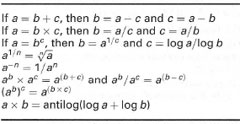Steps in tackling a numerical problem
The step-by-step approach outlined below may not be the fastest method of arriving at an answer, but most mistakes occur where steps are missing, combined or not made obvious, so a logical approach is often better. Error tracing is distinctly easier when all stages in a calculation are laid out.Have the right tools ready
Scientific calculators greatly simplify the numerical part of problem solving. However, the seeming infallibility of the calculator may lead you to accept an absurd result which could have arisen because of faulty key-pressing or faulty logic. Make sure you know how to use all the features on your calculator, especially how the memory works; how to introduce a constant multiplier or divider; and how to obtain an exponent (note that the 'exp' button on most calculators gives you l0x, not 1x or yx; so 1 × 106 would be entered as
| 1 | exp | 6 | , not | 10 | exp | 6 | ) |
Approach the problem thoughtfully
If the individual steps have been laid out on a worksheet, the 'tactics' will already have been decided. It is more difficult when you have to adopt a strategy on your own, especially if the problem is presented in a descriptive style and it isn't obvious which equations or rules need to be applied.
 |
| Table 39.2 Simple algebra - rules for manipulating equations |
- Read the problem carefully as the text may give clues as to how it should be tackled. Be certain of what is required as an answer before starting.
- Analyse what kind of problem it is, which effectively means deciding which equation(s) or approach will be applicable. If this is not obvious, consider the dimensions/units of the information available and think how they could be fitted to a relevant formula. In examinations, a favourite ploy of examiners is to present a problem such that the familiar form of an equation must be rearranged (see Table 39.2 and Box 39.1). Another is to make you use two or more equations in series. If you are unsure whether a recalled formula is correct, a dimensional analysis can help: write in all the units for the variables and make sure that they cancel out to give the expected answer.
- Check that you have, or can derive, all of the information required to use your chosen equation(s). It is unusual but not unknown for examiners to supply redundant information. So, if you decide not to use some of the information given, be sure why you do not require it.
- Decide on what format and units the answer should be presented in. This is sometimes suggested to you. If the problem requires many changes in the prefixes to units, it is a good idea to convert all data to base SI units (multiplied by a power of 10) at the outset.
- If a problem appears complex, break it down into component parts.
The way you present your answer obviously needs to fit the individual problem. Guidelines for presenting an answer include:
- Make your assumptions explicit. Most mathematical models of chemical phenomena require that certain criteria are met before they can be legitimately applied (e.g. 'assuming the sample is homogeneous ... '), while some approaches involve approximations which should be clearly stated (e.g. 'to estimate the volume of a tube, it was approximated to a cylinder with radius x and length y ... ').
- Explain your strategy for answering, perhaps giving the applicable formula or definitions which suit the approach to be taken. Give details of what the symbols mean (and their units) at this point.
- Rearrange the formula to the required form with the desired unknown on the left-hand side (see Table 39.2).
- Substitute the relevant values into the right-hand side of the formula, using the units and prefixes as given (it may be convenient to convert values to SI beforehand). Convert prefixes to appropriate powers of 10 as soon as possible.
- Convert to the desired units step by step, i.e. taking each variable in turn.
- When you have the answer in the desired units, rewrite the left-hand side and underline the answer. Make sure that the result is presented with an appropriate number of significant figures.
Having written out your answer, you should check it methodically, answering the following questions:
- Is the answer of a realistic magnitude? You should be alerted to an error if an answer is absurdly large or small. In repeated calculations, a result standing out from others in the same series should be double-checked.
- Do the units make sense and match up with the answer required? Don't, for example, present a volume in units of m2.
- Do you get the same answer if you recalculate in a different way? If you have time, recalculate the answer using a different 'route', entering the numbers into your calculator in a different form and/or carrying out the operations in a different order.




